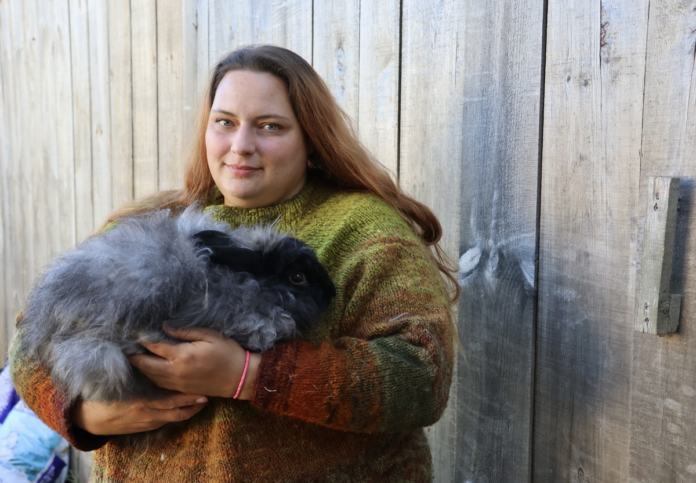On Thursday morning, Susannah Koch wore a sweater made with wool from sheep she had raised, spun into yarn and knit together with her own hands.
Out in the garage at her Swanville farm, a chest freezer held another part of the sheep she’ll put to use: meat from animals that she slaughtered, spent hours butchering with a hacksaw and packaged herself on the property.
Koch learned to butcher them by reading and watching YouTube videos, looking to reduce stress on the animals while saving hundreds of dollars in processing costs. Being present for the last moments of their lives is also important to her on a personal level.
“I do think that dispatching an animal and butchering it would be a great thing for any meat eater to experience, because it changes your perspective on that life, the life that sustains your own,” she said. “I’ve learned a lot.”
Koch isn’t the only one. Other Maine farmers and homesteaders have increasingly turned to processing their livestock at home in recent years, sometimes figuring it out as they go, for similar reasons – and in response to backlogs at traditional butchers that have lingered across the state since the pandemic.
There’s been a “surge of interest” in home butchering as appointments remain hard to get and the homesteading movement’s do-it-yourself ethos continues to grow, according to Colt Knight, who runs the state’s only comprehensive class on the subject for the University of Maine Cooperative Extension.
When the Maine Meat Cutting School started there in 2017, they expected it to offer workforce development for existing licensed processors.
Instead, it’s mostly drawn homesteaders and small farmers; there’s a waiting list of more than 100, according to Knight, and the most recent class sold out within five minutes of registration opening.
For Koch, learning at home took trial and error. Her first experience, using a book’s recommendation to slit the animal’s throat, didn’t work as well on a very woolly sheep and was an “awful” experience, she said.
Now, she uses a .22 revolver to the skull, which kills the animal almost instantly before it knows what’s happening. She then guts it, removes the hide and hangs the carcass for three to four days in the cool temperatures of late fall or early spring so the blood can drain.
Next come many hours of meat cutting with a hacksaw and a knife on a plastic table, preparing packages for the freezer.
“It was very daunting, because it’s like, ‘This is food. I don’t want to screw it up,’” she said of her first attempts. “And then over time I learned, you don’t really screw it up, you just maybe have some uglier pieces.”
If cuts go wrong, they become stew meat or ground mutton, which Koch uses interchangeably with beef in regular recipes. A local woman with butchering experience also helped her learn more about making specific cuts of meat.
Koch has now processed three of her sheep, a deer and numerous rabbits she raises.
“They are like friends to me, but I also feel like I’m doing a good thing in making sure they don’t go to waste, and taking on that burden myself instead of just letting somebody else do it,” she said.
While it’s a difficult process that she doesn’t look forward to, ending their lives at home allows her to have control over their last moments.
That’s important for small homesteaders and farmers like her, who she said often have close relationships with their livestock and are heavily involved with every step of their lives.
“All of the people I know are very concerned with the quality of life that their animals are having, and not having a stressful experience at the end,” she said.
“Mobile slaughter” businesses – professional, licensed butchers that visit farms to kill and process onsite – have also sprung up in Maine to meet some of that demand.
Customers value the reduced stress from staying on-farm, according to some of those operators. It makes small-scale farming more accessible by not requiring a minimum number of animals to process and by eliminating the requirement to round them up into trailers for long transport, they said.
Traditional processing facilities are extremely busy in the fall and winter, according to Knight, but business slows during the rest of the year; it’s always difficult to find workers. At the same time, demand for local meat surged during the pandemic and stayed high.
Some butchers now have waitlists of up to a year. The highly seasonal nature of the work makes it difficult to expand, and building new facilities that meet regulations easily runs more than a million dollars, according to Knight.
If more people had livestock and took them to the butcher at different times, it might ease those problems, he said. The challenges face the rest of the region and nation, not just Maine.
In Koch’s experience, newer homesteaders also miscalculate how long it takes to raise an animal and can struggle to get timely appointments.
If they do get one, they can expect to spend $300-400 to get a pig or sheep butchered depending on its weight, even more for beef. Koch believes doing it at home is the only way to save money by raising meat.
Learning how is very possible, she said; people have been doing it for thousands of years, only recently growing more distant from what it takes to put meat on a table.
“We can ignore that it’s a life that had to die so that we can eat,” she said. “Lots of lives. When you go to the grocery store, that’s lots and lots of animals that have died so that we can eat. When you do it yourself, you just have a different appreciation.”




